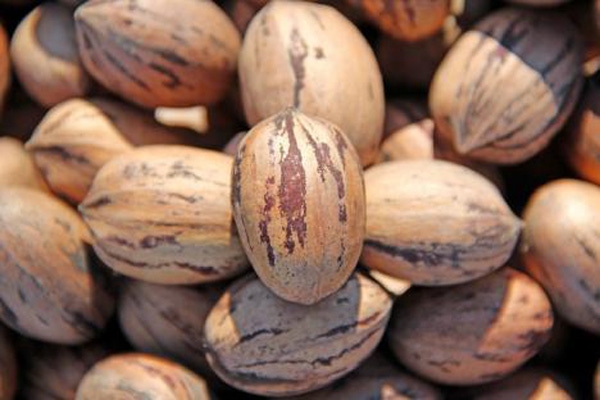June 1, 2016

By the second week of May, the nuts in the pecan orchards at Halsell Farms, Inc. near Rincon, N.M. had just started to form.
“While the nuts aren’t set yet, it looks like we could have a very good crop,” says Bill Halsell. “I’m seeing 4-6 nuts in many clusters.”
While the trees will continue to abort nuts as the season progresses, the August drop is typically the heaviest, he adds. That’s when Halsell will determine how many nuts the trees will carry to maturity.
He says the weather during dormancy was favorable.
“It was an ideal winter for the trees, along with moisture and plenty of cold temperatures,” Haskell says.
Now in his 47th season, the northern Doña Ana County grower has 550 acres of producing pecan trees and another 200 acres expected to produce their first marketable crop in 3-4 years.
Halsell is hoping this year’s crop fares better than the last one. An unusually late frost im mid-April cut yields by about 20 percent. Also, a surprise hail storm in October knocked nuts off the trees in some of his blocks. He was able to salvage most of them in good shape.
If not for the freeze and hail, Halsell figures his yields last year would have averaged about 2,500 pounds per acre.
The toll on his crop from the weather damage was softened somewhat by a respectable meat yield of 55-57 percent, plus record high in-shell prices of about $2.80-$2.90.
This year, Halsell says rainfall so far has been about normal. He reports good soil moisture levels in the fields and ample supplies of groundwater which he uses to flood irrigate most of his acreage.
He also flood irrigates his remaining blocks of trees with surface water from the Rio Grande River, delivered by the Elephant Butte Irrigation District.
Halsell expects to receive about 1 acre foot of surface water for 2016. That’s quite a bit more than over the last 6-7 years. Groundwater provides for the remaining tree water needs.
His full allocation of surface water is 4.5 acre feet.
“We seldom use that much due to the summer rains,” he says. “However, unless we get at least two inches of rain, we will not delay an irrigation.”
This season, as usual, Halsell began irrigating his trees in early March every other week. Once summer weather sets in, he will irrigate about every 8-10 days.
At one time, the only significant insect threat to his crop was yellow aphids. However, over the past decade or so the pecan nut casebearer has also become a problem. Although this pest produces three flights a season, Halsell is most concerned about the first generation.
Casebearer larvae feed inside small nutlets from April to June when one larva can destroy all the nutlets in a cluster. Larvae of later generations are less damaging. By then, since the nuts are larger, the larvae require no more than 1-2 nuts to feed.
Halsell times his insecticide sprays to control the pecan nut casebearer based on pheromone trap counts. The first treatment was made the third week of May. Typically, he sprays for the pest 2-3 times during the season, depending on the population levels.
On the fertilization side, Halsell fertilizes the trees based on results of a leaf analysis in the spring, and applies zinc, phosphate, and trace minerals as needed.
Supplemental nitrogen is the main nutrient required in the orchards; applied four times a season in the form of ammonium sulfate. The sulfur lowers the pH levels in his alkaline soils.
To deal with increased soil salinity levels due to groundwater use, Halsell uses two post-harvest practices to enhance the salt-leaching effects of his irrigations. He rips the soil to a depth of 30 inches and then trenches alongside the trees - first on one side and then the other - until he hits water or reaches a depth of 13 feet.
Halsell is one of an overwhelming majority of voting growers in the nation’s 15 pecan-producing states who recently voted in favor of a referendum to establish a federal marketing order for pecans.
This industry self-help program, which includes Arizona, California and New Mexico, is designed, in part, to increase consumer demand for pecans.
“I think it will be good for growers in the long run,” he says. “We have to expand our markets overseas. Several years ago, I participated in a trade mission to China where we’re doing a good job promoting the value of American pecans. We can do much better.”
You May Also Like




